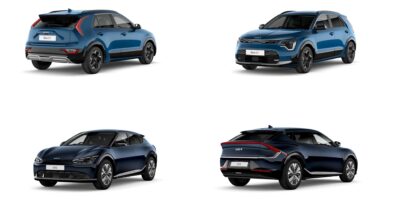The arrival of the all-new BMW 1 Series heralds the dawn of a new era for this successful model that has consistently combined handling excellence, practicality, technology and quality.
Now in its third generation, the BMW 1 Series features a dynamic design, roomier interior, a raft of cutting-edge technologies as well as BMW’s trademark agility and superior performance.
It features a shorter bonnet and significantly more space within a footprint almost identical to that of its predecessor. At 4,319 millimetres, the new BMW 1 Series is five millimetres shorter, 34 millimetres wider and 13 millimetres higher. At 2,670 millimetres, the wheelbase is 20 millimetres shorter.
There have been a number of design changes including a new standard LED headlight arrangement, a more wedged shaped silhouette and a pronounced ‘shark nose’. At the front, the BMW kidney grille is larger and, for the first time in this model range, the kidneys merge in the middle. The range-topping BMW M135i xDrive features a distinctive grille with a mesh design instead of the classical bars.
Viewed from the side, the BMW 1 Series features a distinctive window graphic enhanced by two character lines. One runs below the door handles from the front wheels to the rear wings, while the other starts in the lower part of the front door before lifting towards the rear quarter. In addition, the greenhouse is elongated with the traditional Hofmeister Kink now incorporated into the C pillar.
Enhanced levels of interior and boot space
The front-wheel-drive architecture with transverse engines and a lower centre tunnel offers the occupants more space than in the predecessor. This applies especially to those in the rear seats. Access is easier and there is an extra 33 millimetres of knee-room available. Rear headroom is up by 19 millimetres when the outward opening panoramic sunroof is fitted. Rear passengers also enjoy 13 millimetres more elbowroom, while the driver and front passenger get an extra 42 millimetres in this respect. Luggage compartment capacity rises by 20 litres to 380 litres (1,200 litres with the rear seat bench folded down). The minimum width of the luggage compartment has also increased by 67 millimetres. An electrically operated tailgate is now optionally available for the BMW 1 Series for the first time.
Panoramic roof available as an optionÂ
For the first time a panoramic roof is available as an option for the BMW 1 Series. With a 0.7m glass area, the roof features an electrically operated roller blind to provide shading along with a net wind deflector to reduce noise when open.
Three equipment lines and one flagship modelÂ
The BMW 1 Series offers SE, Sport and M Sport trims as well as the range-topping M135i xDrive, all of which differ from one another in both exterior and interior details. SE comes with matt black air guide grilles on the front bumper, while Sport adds exclusive air inlets finished with a high-gloss black, the kidney grille features a chrome frame with high-gloss black struts. The M Sport features aerodynamic bodystyling as well as satin aluminium struts in the kidney grille whilst the seat upholstery is in Dakota leather with contrast stitching. The range-topping BMW M135i xDrive incorporates the mesh-design BMW kidney grille and frame, exclusive front bumper air inlet clasps, and wing mirrors all finished in Cerium Grey. Exclusive black high-gloss rear diffuser with mesh design, and side sill covers featuring exclusive M135i xDrive black high-gloss inserts complete the look. Inside there’s the M Sport seat with integrated headrest design finished in Trigon Cloth/Alcantara Anthracite upholstery.
Transfer of technology from the BMW i3sÂ
The new BMW 1 Series features the actuator contiguous wheel slip limitation (ARB) technology used in the BMW i3s. This is the first time it has been used in a combustion-engine car and it has the effect of significantly improving traction when pulling away, cornering or when driving in the wet. The system works in close tandem with the DSC system to significantly reduce power understeer.
ARB is assisted in its task by BMW Performance Control (yaw moment distribution). This feature, which is also included as standard on the BMW 1 Series, gives it more agile handling by intelligently applying the brakes at the wheels on the inside of the bend. This suppresses any initial understeer and gives the car neutral steering behaviour. Alternatively, drivers can engage the DSC system’s propulsion-optimised Dynamic Traction Control (DTC) setting, which allows a greater degree of slip at the driven wheels and thereby paving the way for a ‘sportier’ driving style.
Two models with BMW xDrive intelligent all-wheel drive
ARB technology and BMW Performance Control also feature on the BMW 120d xDrive and the BMW M135i xDrive, which are both equipped with BMW xDrive intelligent all-wheel drive as standard. This can split drive power 50:50 if necessary and is designed to ensure predictable handling in all driving situations. This applies even if the Driving Experience Control switch is set to Sport mode, DTC is selected or DSC is deactivated.
In Comfort or Eco Pro mode, drive is split as required, while keeping fuel consumption as low as possible. Fuel economy is therefore improved without any discernible impact on driving dynamics or traction. As well as the all-wheel-drive system, standard specification for the BMW M135i xDrive includes a newly developed mechanical Torsen limited-slip differential, which gives the car an even sportier edge.
The differential is integrated into the standard eight-speed Steptronic Sport transmission on the BMW M135i xDrive and also features a Launch Control mode that puts the full peak torque of 450Nm on tap in first and second gear.
Three suspension options
Besides the standard suspension and the M Sport suspension with 10mm reduction in ride height, the new BMW 1 Series can also be specified with the Adaptive suspension including VDC (Variable Damper Control) as an option (not available in conjunction with 19-inch alloy wheels or the M Sport Plus Pack). This lets the driver choose from two different damping response settings via the Driving Experience Control switch, namely Comfort – for better ride comfort in poor road conditions – or Sport for a very sporty drive.
Engine line-up
The all-new BMW 1 Series is powered by three-cylinder and four-cylinder engines with a choice of three diesel and two petrol engines at launch. Improvement in the power units’ efficiency have resulted in higher real-world fuel economy and lower exhaust emissions. Performance characteristics have likewise been enhanced and, in some cases, output has been increased too. The line-up is spearheaded by the newly developed power unit for the BMW M135i xDrive, the BMW Group’s most powerful four-cylinder engine.
| Model | Power output (hp) |
Peak Torque (Nm) |
Acceleration (zero to 62mph) |
Top Speed (mph) |
Fuel consumption (mpg) WLTP |
COÂ 2Â emissions (g/km) NEDC* |
OTR Price from |
| 118i | 140 | 220 | 8.5 | 132 | 47.1 – 40.4 | 123-114 | £24,430 |
| M135i xDrive | 306 | 450 | 4.8 | 155 | 35.3 – 34.4 | 157-155 | £36,430 |
| 116d | 116 | 270 | 10.3/10.1 | 124 | 61.4 – 54.3 | 103-100 | £25,480 |
| 118d | 150 | 350 | 8.5/8.4 | 135/134 | 60.1 – 51.4 | 111-108 | £26,640 |
| 120d xDrive Sport | 190 | 400 | 7.0 | 143 | 51.4 – 48.7 | 119-117 | £32,470 |
In the 1.5-litre three-cylinder engine powering the entry level BMW 118i, modifications have cut CO2Â emissions by 29g/km at the same time as boosting maximum power output by 4hp to 140hp. The power unit, which is five kilograms lighter than the one it replaces, generates peak torque of 220Nm. The BMW 118i accelerates from zero to 62mph in 8.5 seconds and goes on to a top speed of 132mph. It posts combined fuel consumption of 47.1-40.4mpg with CO2Â emissions of 123-114g/kg.
The newly developed 2.0-litre unit under the bonnet of the M135i xDrive model is BMW Group’s most powerful four-cylinder petrol engine. It delivers 306hp with the help of BMW TwinPower Turbo technology and peak torque is 450Nm. It accelerates from zero to 62mph in 4.8 seconds, while top speed is limited to 155mph. The M135i xDrive returns 35.3-34.4mpg and emits 157-155g/km of CO2.
Three diesel units will be available for the new BMW 1 Series from launch and upgrades have brought about a reduction in fuel consumption – and therefore CO2 emissions – of around five per cent, at the same time as lowering other pollutant emissions. The BMW 116d is powered by a 1.5-litre 116hp three-cylinder engine with a maximum torque of 270Nm, while returning 61.4-54.3mpg and emitting CO2 of 103-100g/km. This is sufficient for a top speed of 124mph and a zero to 62mph benchmark time of 10.3 seconds (10.1 seconds with the seven-speed Steptronic dual-clutch transmission).
The BMW 118d and 120d xDrive, which feature two-stage turbocharging, are powered by 2.0-litre four-cylinder diesel engines. The 118d returns 60.1-51.4mpg with CO2Â emissions of 111-108 g/km. The output of the BMW 118d peaks at 150hp while maximum torque is 350Nm. The zero to 62mph sprint takes 8.5 seconds (8.4 seconds with eight-speed Steptronic transmission) and top speed is 135mph (134mph with Steptronic).
The BMW 120d xDrive features BMW xDrive intelligent all-wheel drive and the eight-speed Steptronic automatic transmission as standard. Its four-cylinder power unit produces 190hp and a peak torque of 400Nm. The 120d xDrive accelerates from zero to 62mph in 7.0 seconds reaching a top speed of 143mph. Combined fuel consumption is at 51.4-48.7mpg while emitting 119-117g/km CO2.
First ever deployment of three different transmission technologiesÂ
The arrival of the new BMW 1 Series marks the first time three different transmission technologies have been employed in the range. In the BMW 116d, BMW 118d and BMW 118i, the engine’s power is delivered via an upgraded six-speed manual gearbox. New to the BMW 1 Series line-up is the highly sophisticated seven-speed Steptronic dual-clutch transmission, which can be specified as an option for the BMW 116d and the BMW 118i. This allows faster gear changes with no interruption in power delivery and the long seventh gear keeps revs low, helping to lower fuel consumption when out of town or on the motorway. Further improvements have been made to the shift comfort and acoustic properties of the eight-speed Steptronic Sport transmission fitted as an option in the BMW 118d and as standard in the BMW 120d xDrive and the BMW M135i xDrive.
The all-new BMW 1 Series will be available for Customer delivery from late September with prices starting from £24,430.
*Article Source http://www.press.bmwgroup.com








